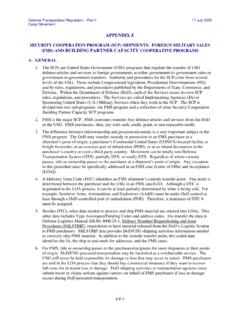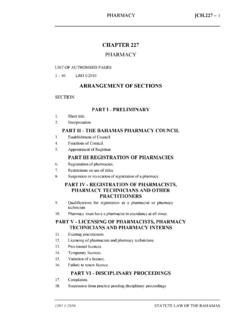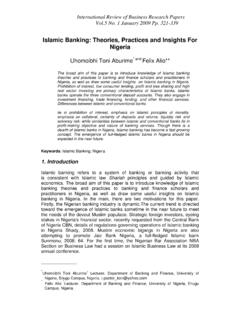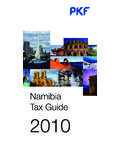Transcription of United States Northern Command (USNORTHCOM), Part V ...
1 Defense Transportation Regulation Part V 14 May 2020 Department of Defense Customs and Border Clearance Policies and Procedures V-514-1 CHAPTER 514 United States Northern Command ( usnorthcom ) A. GENERAL This chapter identifies regulations or directives and establishes Customs/Border Protection requirements and procedures and organizational points of contact (POC) responsible for the entry/exit of material and personnel from the various countries listed. B. SPECIFIC COUNTRY DETAIL The following provide the most up-to-date overseas customs process information and/or exceptions that have been obtained for usnorthcom countries: 1. Passenger: See the Department of Defense (DoD) Foreign Clearance Guide at 2. Personal Property: See the Personal Property Consignment Instruction Guide (PPCIG) at 3. Cargo: This chapter documents the requirements and other exceptions for the following countries: The Bahamas Canada Mexico Puerto Rico Virgin Islands C.
2 BAHAMAS, THE Cargo: No country-specific details. D. CANADA 1. Cargo. Shipments to Canada (via all modes) must clear both United States ( ) Customs and Border Protection (CBP) (for export) and Canada Border Services Agency (for import). The CBP monitors exports of defense articles from the United States to Canada. Most DoD shipments to Canada are exempt from requiring an export license under 22 CFR , Canadian Exemptions. However, items on the United States Munitions List (USML) must be shipped using a commercial bill of lading (CBL) and must have an Electronic Export Information (EEI) filed electronically through direct interface with the Automated Commercial Environment (ACE). Refer to Chapter 508 for additional information on export documentation requirements and EEI preparation. a. CBL annotations depend on the category of shipment. Shipments to Canada fall into two categories: Government-owned or items procured by the Canadian Department of National Defense (DND).
3 (1) When shipping Government-owned material that will remain so while in Canada, the CBL will be annotated with the following statement: Free entry under Canadian customs, Tariff Item Value for Canadian customs purposes $ (dollar amount). When a military vehicle is carrying this shipment, it must have the approved Cross Border Movement Request on hand, along with a copy of the vehicle Defense Transportation Regulation Part V 14 May 2020 Department of Defense Customs and Border Clearance Policies and Procedures V-514-2 manifest for Canadian customs purposes, which must be presented to Canadian customs upon entry. When a commercial Transportation Service Provider (TSP) transports a shipment consigned either to either a military unit collocated with a Canadian DND unit or directly to a Canadian DND unit, the following are required: a copy of the CBL, the name of the commercial TSP transporting the material, when the material will enter Canada, and which border crossing will be used.
4 Fax this information to the National Defense Headquarters Canada Forces (NDHQ CD) Customs at 1-800-306-1811. If necessary, contact the NDHQ CD Customs section at or 1-855-210-5149. (2) When shipping items procured by the DND, an EEI is required to be filed with references to each DD Form 1348-1A, Issue Release/Receipt Document, Figure 514-1, including the Document Identification, description, and value. Attach a copy of each DD Form 1348-1A to the CBL. The CBL must include the external transaction number or internal transaction number for the EEI. The commercial TSP must be Canadian customs bonded. The DND broker for Canadian customs clearance must deliver all shipments In Bond . (3) When shipping USML items to commercial contractors in Canada under 22 CFR , the contractor must be registered with the Canadian Controlled Goods Program. Registered companies using the Controlled Goods Program can be located at 2.
5 Cargo Description. For movements between a Continental United States (CONUS) location and Canada for export, the shipment description from the origin CONUS location to Canada must meet the following requirements to ensure compliance with customs requirements upon the shipment s arrival at the border crossing and preclude shipment delays: a. For export shipments, shippers must provide an accurate, in-the-clear description of the items to be transported from the requisition source data presented to display this description on the shipment documentation. b. Using terms such as NOS (not otherwise specified), STC (said to contain), FAK (freight all kinds), Consolidated Cargo, or General Merchandise or providing no description/leaving the field blank is not acceptable for customs clearances purposes. Generic descriptions such as aircraft part or electronic part may result in delays in the customs clearance process and must not be used.
6 The best available nomenclature based on NSN and other data presented by the supply activity must be used. E. MEXICO 1. Cargo. No country-specific details. 2. Cargo Description. For movements between a CONUS location and Mexico for export, the shipment description from the origin CONUS location to Mexico must meet the following requirements to ensure compliance with customs requirements upon the shipment s arrival at the border crossing and preclude shipment delays: a. For export shipments, shippers must provide an accurate, in-the-clear description of the items to be transported from the requisition source data presented to display this description on the shipment documentation. b. Using terms such as NOS (not otherwise specified), STC (said to contain), FAK (freight all kinds), Consolidated Cargo, or General Merchandise or providing no description/leaving the field blank is not acceptable for customs clearances purposes.
7 Generic descriptions such as aircraft part or electronic part may result in delays in the Defense Transportation Regulation Part V 14 May 2020 Department of Defense Customs and Border Clearance Policies and Procedures V-514-3 customs clearance process and must not be used. The best available nomenclature based on NSN and other data presented by the supply activity must be used. F. PUERTO RICO Cargo: No country-specific details. G. VIRGIN ISLANDS Cargo: No country-specific details. Defense Transportation Regulation Part V 14 May 2020 Department of Defense Customs and Border Clearance Policies and Procedures V-514-4 Figure 514-1. DD Form 1348-1A, Issue Release/Receipt Document





